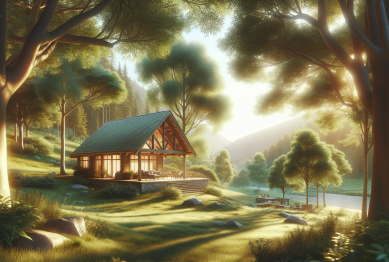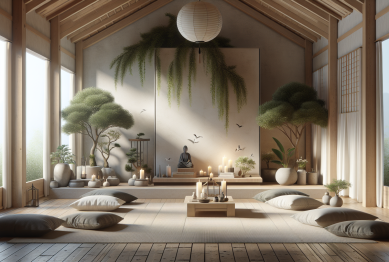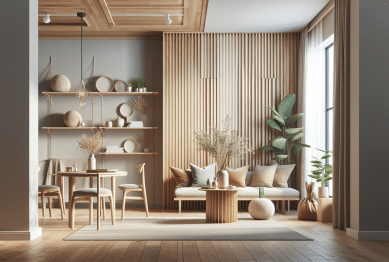Discover how tiny home living is transforming lifestyles and entertainment choices. This guide explores space-saving design, eco-friendly benefits, decluttering habits, and clever ways people maximize small spaces for comfort, creativity, and joy.
The Appeal of Tiny Home Living
Tiny home living has captured the imagination of many in search of simplicity and creativity. Downsizing to a compact space isn’t just about letting go—it’s also about intentionally making room for what matters most. People are drawn to this lifestyle for practicality, affordability, and a chance to live with less clutter. By optimizing living spaces, tiny home enthusiasts manage to blend function, beauty, and comfort in unique ways. The minimalist home movement invites individuals to rethink needs versus wants, resulting in intentional living and greater emotional satisfaction. Tiny home living has become a statement of thoughtful design and mindful consumption, encouraging others to consider what truly brings them joy.
Many choose tiny homes for their environmental benefits, too. Smaller spaces require fewer resources to build and maintain, reducing energy consumption and carbon footprints. Solar panels, composting toilets, and rainwater harvesting are popular sustainable upgrades among tiny home owners. The joy of having a smaller space to clean, decorate, and maintain makes life less overwhelming, enabling people to devote more time to passions, relationships, or experiences. This new perspective on housing redefines the role a living space plays in overall well-being, proving that less can really mean more.
Entertainment and lifestyle options look different for those embracing tiny living. Outdoor spaces become extensions of the home—think patio movie nights or container gardening. The shift encourages connecting with local communities and spending time outside, blending entertainment with wellness. Tiny house communities often host shared potlucks and events, fostering connection. In the quest for fulfilling lives, many discover that the tiny home lifestyle is about creating experiences, both inside and out, that truly enrich day-to-day living (Source: https://www.habitat.org/stories/why-tiny-houses-are-popular).
Maximizing Small Spaces With Smart Design
Making the most of tiny spaces means embracing creative solutions. Multi-functional furniture, such as storage beds and convertible dining tables, helps maximize every inch. Built-in shelving and lofted sleeping areas offer vertical storage, freeing up valuable floor space. Clever design transforms what could feel cramped into comfortable, airy homes. Living in a tiny home pushes individuals to experiment with room layouts and test what feels natural. Even with limited square footage, inventive storage transforms spaces.
Open floor plans, abundant windows, and light color palettes can also make a miniature home feel larger. Natural light is especially important in generating an open, fresh atmosphere. Mirrors, sliding doors, and minimalistic décor eliminate visual clutter, providing a seamless flow. Many tiny homes incorporate nature-inspired elements—like indoor plants and wooden textures—that bring warmth while maintaining simplicity. Homeowners frequently personalize spaces with bold pops of color or unique artwork, proving that small never has to be boring.
The kitchen, often the heart of any home, is reimagined in a tiny house. Fold-down countertops, modular storage, and under-cabinet lighting contribute to efficiency. Appliances are often streamlined, with two-burner stoves, small refrigerators, and all-in-one washer-dryer units being common. Maximizing vertical space with hanging racks or pull-out pantries allows the kitchen to remain functional and inviting. The result is a cozy but not crowded space designed to support daily routines and creativity in meal preparation (Source: https://www.energy.gov/energysaver/articles/small-and-tiny-homes-energy-saving-ideas).
Eco-Friendly Benefits and Sustainability
Tiny homes stand out for their inherently eco-friendly appeal. Reduced energy and material consumption mean a lighter ecological footprint, which is important for many living this lifestyle. Many tiny house dwellers opt for sustainable building materials like reclaimed wood, energy-efficient windows, and low-chemical insulation. The small size means heating and cooling uses less energy, so savings are immediate and noticeable. Some even take advantage of off-grid capabilities, such as solar power and rainwater collection, for increased independence.
This movement encourages mindful consumption and responsible waste management. Living with fewer items motivates people to purchase with intention and choose higher-quality, longer-lasting goods. Composting systems and eco-friendly toilets can reduce water use and repurpose organic waste for gardening. The adoption of solar panels is not only cost-effective in the long term but also supports sustainable habits. Choosing location is also a sustainability decision—parking in places with walkable access to amenities further cuts dependency on cars.
Tiny home communities often include sustainability education. Residents share know-how and resources, exchanging ideas about energy efficiency and eco-friendly living. These neighborhoods sometimes collaborate to build communal gardens or renewable energy projects, multiplying the sustainability impact. The collective mindset supports broader environmental goals, showing how individual and group efforts add up over time (Source: https://www.epa.gov/smartgrowth/tiny-houses-affordable-sustainable-living).
Decluttering: Finding Joy With Less
Downsizing is central to the tiny home lifestyle. People are often surprised by how freeing it feels to let go of unused possessions. Decluttering isn’t about deprivation—it’s about opening space for what matters. The process can be emotional, as items carry memories, but learning to curate belongings creates room for clarity and calm. Strategic organization becomes second nature in a small home, where every object has a purpose. Many find that letting go of unnecessary items is the first step toward embracing a simpler, more intentional life.
The tiny home community has helped popularize decluttering methods that transform routines. Capsule wardrobes, digital libraries, and multipurpose kitchen tools all support streamlined living. Owners often rotate seasonal belongings, keeping only necessities on hand and storing or donating the rest. The results are clearer surfaces, less visual chaos, and more mental space for hobbies or leisure. Decluttering, when tackled mindfully, is empowering—it moves the focus from things to experiences, relationships, and goals.
Decluttering extends beyond possessions to digital life as well. Living small often sparks awareness of how cluttered schedules or social media feeds can drain time and focus. Many tiny home residents incorporate digital detox practices, such as setting device-free hours. This encourages deeper engagement with surroundings, whether reading a book, pursuing a creative project, or simply enjoying the moment. The less-is-more mindset transforms not just the physical home, but patterns of thought and behavior (Source: https://www.psychologytoday.com/us/blog/mindful-self-express/201807/the-life-changing-magic-decluttering).
Entertaining in a Tiny Home: Creative Solutions
Hosting friends in a small space presents fun challenges. Flexible seating, folding tables, or floor cushions make it easy to accommodate guests. Many tiny home dwellers get creative with outdoor entertaining, transforming a porch or yard into a social hub. Hanging lights, portable fire pits, or outdoor cinemas turn compact patios into cozy gathering spots. Entertainment is more about atmosphere and connection than space or extravagance.
Food and drink are central to entertaining, even with minimal kitchens. Potlucks, DIY snack stations, or charcuterie boards are practical solutions that require little preparation space. Think shared meals, board games, and music nights—these activities thrive in intimate settings, encouraging close conversation and plenty of laughter. Space limitations spark creativity and encourage more collaborative, interactive forms of fun.
For those passionate about arts or hobbies, tiny homes become a stage for small gatherings, crafting sessions, or movie marathons. Hosting workshops or book clubs is not just possible, it’s often easier on a human scale. Tiny home living shows that entertainment thrives when people focus on the experience, not square footage. The takeaway? Connection comes first, and memorable moments don’t require a lot of room (Source: https://www.hgtv.com/lifestyle/clean-and-organize/host-in-style-in-your-tiny-home).
The Emotional Rewards and Challenges of Tiny Living
Tiny home living offers emotional rewards, including a sense of pride, self-reliance, and personal growth. Achieving comfort in a small environment requires adaptability and a willingness to solve unique problems. People learn what truly lifts their spirits—be that a hobby corner, a favorite reading nook, or a view of nature from the window. Personalization is the key to comfort, and every inch can be tailored for optimal happiness.
The journey involves challenges, too. Downsizing can be physically and mentally taxing. Space constraints demand careful planning, especially for families or those working from home. Privacy can be an issue, prompting creative solutions like insulated curtains, sound machines, or designated quiet corners. It takes patience to find what works and what doesn’t, as well as embracing imperfection as part of the process.
Support from the tiny home community—online forums, groups, and local meetups—is vital. Sharing stories and tips helps newcomers overcome doubt and adjust expectations. The camaraderie and shared knowledge found among tiny home enthusiasts can turn potential obstacles into sources of inspiration. The tiny home movement continues to grow because it addresses deeper dreams of meaningful, connected living experiences (Source: https://www.curbed.com/article/tiny-house-tips-living-small.html).
References
1. Habitat for Humanity. (n.d.). Why tiny houses are popular? Retrieved from https://www.habitat.org/stories/why-tiny-houses-are-popular
2. U.S. Department of Energy. (n.d.). Small and Tiny Homes: Energy Saving Ideas. Retrieved from https://www.energy.gov/energysaver/articles/small-and-tiny-homes-energy-saving-ideas
3. U.S. Environmental Protection Agency. (n.d.). Tiny Houses: Affordable, Sustainable Living. Retrieved from https://www.epa.gov/smartgrowth/tiny-houses-affordable-sustainable-living
4. Psychology Today. (2018). The Life-Changing Magic of Decluttering. Retrieved from https://www.psychologytoday.com/us/blog/mindful-self-express/201807/the-life-changing-magic-decluttering
5. HGTV. (n.d.). Host in Style in Your Tiny Home. Retrieved from https://www.hgtv.com/lifestyle/clean-and-organize/host-in-style-in-your-tiny-home
6. Curbed. (n.d.). Tiny House Tips: Living Small. Retrieved from https://www.curbed.com/article/tiny-house-tips-living-small.html









